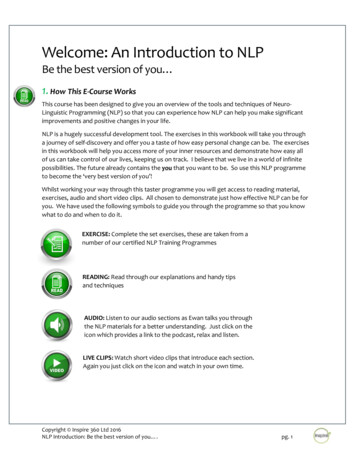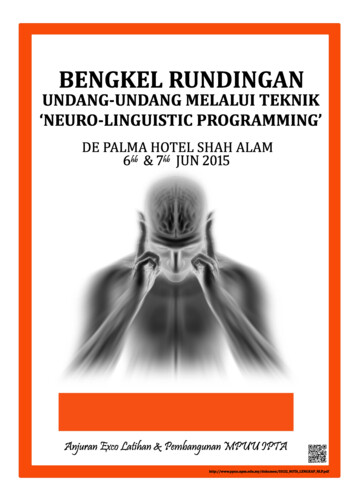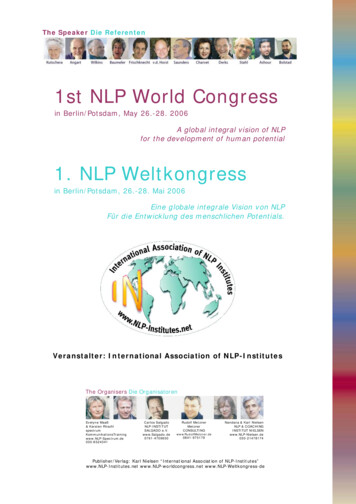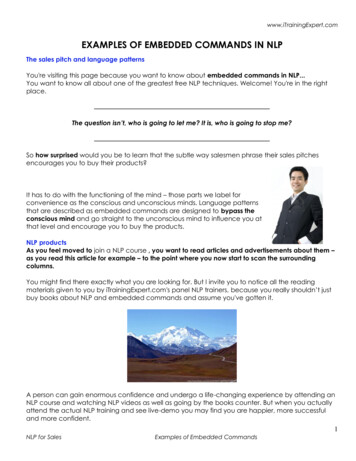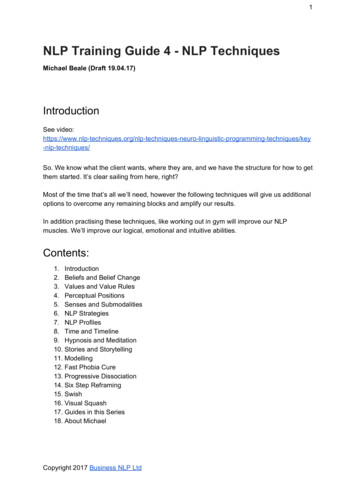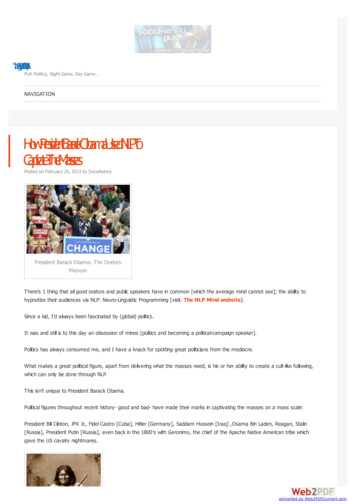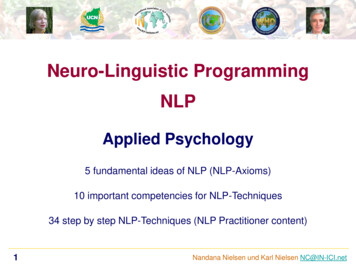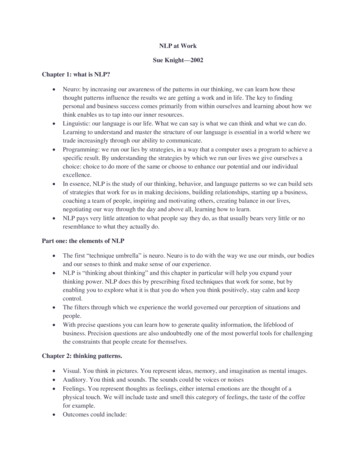
Transcription
NLP at WorkSue Knight—2002Chapter 1: what is NLP? Neuro: by increasing our awareness of the patterns in our thinking, we can learn how thesethought patterns influence the results we are getting a work and in life. The key to findingpersonal and business success comes primarily from within ourselves and learning about how wethink enables us to tap into our inner resources.Linguistic: our language is our life. What we can say is what we can think and what we can do.Learning to understand and master the structure of our language is essential in a world where wetrade increasingly through our ability to communicate.Programming: we run our lies by strategies, in a way that a computer uses a program to achieve aspecific result. By understanding the strategies by which we run our lives we give ourselves achoice: choice to do more of the same or choose to enhance our potential and our individualexcellence.In essence, NLP is the study of our thinking, behavior, and language patterns so we can build setsof strategies that work for us in making decisions, building relationships, starting up a business,coaching a team of people, inspiring and motivating others, creating balance in our lives,negotiating our way through the day and above all, learning how to learn.NLP pays very little attention to what people say they do, as that usually bears very little or noresemblance to what they actually do.Part one: the elements of NLP The first “technique umbrella” is neuro. Neuro is to do with the way we use our minds, our bodiesand our senses to think and make sense of our experience.NLP is “thinking about thinking” and this chapter in particular will help you expand yourthinking power. NLP does this by prescribing fixed techniques that work for some, but byenabling you to explore what it is that you do when you think positively, stay calm and keepcontrol.The filters through which we experience the world governed our perception of situations andpeople.With precise questions you can learn how to generate quality information, the lifeblood ofbusiness. Precision questions are also undoubtedly one of the most powerful tools for challengingthe constraints that people create for themselves.Chapter 2: thinking patterns. Visual. You think in pictures. You represent ideas, memory, and imagination as mental images.Auditory. You think and sounds. The sounds could be voices or noisesFeelings. You represent thoughts as feelings, either internal emotions are the thought of aphysical touch. We will include taste and smell this category of feelings, the taste of the coffeefor example.Outcomes could include:
o Visual, an image of all the agreed actions written up on a whiteboard with names againsteach one.o Auditory, people talking to each other at the close of a meeting, making comments suchas: that’s been really useful. I know exactly what my department has to do next.o Feelings, thoughts about shaking hands with other people at the meeting and a satisfied,warm feeling.We need to be able to offer choices that our customers only realize are important to them whenthey experienced the difference.A clue to the way we think is how we move our eyes.Good spellers will typically look up, eyes right or eyes left, to see a word in their minds eye.Let’s consider these distinctions in thinking patterns in more detail.o Brightness: bright or dim, dull or sparkly?o Clarity: Damon hazy or sharp and focused?o Size: larger than life, life size or smaller than life?o Color/black and white: full color, shades of gray, particular color, black and white?o Location: in front of you, to the side, behind you?o Distance: close or distant?o Motion: still snapshots or movies?o Speed: fast/slow?o Framed/panoramic: closing frame or panoramic?o Sequence: in order/random/simultaneous images?o Associated/disassociated: are you seeing it as if out of your own eyes, or can you seeyourself in the picture?Think for example, about your journey to work. You can change your experience of this journeyto make it better or worse by experimenting with your thinking about it. Start by changing someof the visual distinctions. For example, if it is Damon turn up the brightness. Then put it backwhere it was. If it is still, make it into a movie.Auditory distinctions and patterns:o Volume: how loud/quiet?o Speed: fast or slow?o Location: where is the source of the sound, is it in front of you, to one side, behind you?o Distance: is the sound close or far away?o Voice/sound: it is a voice or can you hear other sounds?o Pitch: high/low/mid range?Feeling distinctions:o Pressure: what sort of pressure can you feel, is there a sense of being pushed, a general orspecific pressure Russian Marko Location: when your body do experience the sensations?o Motion: is there movement to the feeling? Is a fluttery, steady, and tingling?o Temperature: hot/cold/stamp?o Intensity: strong/weak.o The pace: is it fast feeling, a slow one?The swish pattern. The swish is a technique for utilizing these distinctions in thinking to replace aproblem state with the desired state. It is fast and powerful, as well as being great for dealing with
unwanted behavioral habits. Note that the swish will not necessarily be ideal for deeper, moresignificant issues. There are other techniques later in the book that can help you with these.o First, identify their response and yourself that you want to change. Where exactly is thereaction you would like to replace? For example, you might want to change the state suchas anxiety or apprehension.o Identify precisely what is that triggers this response. There will be something specific thatimmediately precedes your reaction. Identifying this trigger is a key part of the process.If, for example, it is a response to the way in which someone speaks to you, identify whatit is they say or what it is about the way they say it that triggers your reaction. We createthis in your thinking in exactly the way it happens. If it is the way in which someonespeaks to you, then steer them saying the words exactly the way they do. If it is the site ofan audience in front of you, imagine yourself in that situation looking at the audience inthe way you do. See exactly what you see as if you were there.o Now determine which facets of the way you think about this trigger have the greatesteffect. There will be some elements that intensify your reaction. The swish lends itselfmost readily to visual triggers and most often the size and brightness of the image havethe greatest impact. For example, if it is the site of a certain person who works for youthat triggers a response, experiment with each distinction in turn, putting the image backthe way it was before you experiment with the next one. The aim is to find the one or twothat intensify the response. Although these elements are currently triggering the responsethat you don’t want, the aim of the swish is to hook these elements to the response thatyou do want. In doing so, you’re making your own resources work for you rather thanagainst you.o Think about something completely different to “break your state.” For example, whatcolor was the front door of the house in which you lived last?o Now imagine that the person you would like to be, irrespective of what you have been inthe past and irrespective of any specific behavior. This is an opportunity to imagine howyou would like to be, the sort of qualities you would really like to have, the style that fitswith who you truly are. Imagine this as if you are looking at yourself as an observer,disassociated. Develop this until you have an image that is compelling and desirable.Check that this you really fits in with the significant people in your life—it needs to be areal benefit to them to free to be this new way. Explore how this fits with whatever senseof purpose you have, with your beliefs and values, with every aspect that is important toyou. Check that this new you meet any needs that you may have been satisfying and lesshealthy ways in the past. If for example, you have been getting attention for beingstressed, check that you are going to get the level and quality of attention you need fromthis new way of being in the world.o Think of something completely different to break state again—for example, yourtelephone number backwards.o Make an image of the trigger, a stimulus that prompts the response that you want tochange. Use the key factors that enhance the trigger. For example, if the distinctions ofsize and brightness intensify the trigger, make this image bright and big.o Take the image of the new you and make it small and dark. Place this small, dark imagein the corner of the bigger image.
oooThey quickly make the large image small and the dark and at the same time make thesmall image large and bright. Do this as fast as you can: the speed is important. You canmake a sound to company this movement, a swish sound, hence the name of the process.Break state again. Clear the images so you start fresh. Create a new image so you canbreak the image before you start again, otherwise you may set up a loop in your thinking.Repeat the process 5 to 10 times and check to see if it works.Chapter 3: filters on your world. When Janet and Bill had a conversation, each found the other frustrating. Janet like to discuss thedetails of what was needed, whereas Bill prefer to discuss the broader strategic concepts. Forexample, Janet would say, “I’d like Peter to go to the next meeting,” and Bill would reply, “Wehaven’t decided on the main areas of the plan that didn’t work.” Jens conversation centered onfuture actions, whereas Bill concentrated more on the past. Janet would pay attention to thesimilarities between one situation and another: this is like another idea I have about what wemight do to improve the office layout. Bill would concentrate on the exception by saying thingslike: no, this is different or we didn’t include an overall plan. It was if Janet and Bill were talkingdifferent languages. They had different filters on their experience. They didn’t find meetings withone another easy.Skill lies in choosing either an associated or a disassociated state for purpose. The appropriatechoice depends on your desired outcome. You might choose to disassociate to protect yourselffrom painful emotions, or you might choose to associate in order to fully experience all thefeelings of the situation. Did you know that for most people decision-making takes place througha feeling? If your preferred style is to keep yourself and others disassociated, don’t be surprised ifyou and they struggle to make decisions. If your business depends on supporting others in makingdecisions, you need to know how to associate and how to help others do the same.One of the directors of a marketing company found that she was struggling to get potential clientsto make a decision about the work for company was proposing.Your ability to think about what you really want is known as towards thinking. Your ability tothink about what you don’t want is known as away from thinking.When looking at shapes and patterns, what do you notice? Do you notice in what ways they aresimilar, they are all oval, or did you notice that to our upright and one is on the side? In effect, doyou look for what is the same—match—but you look at what’s different—mismatch?When meeting a person for the first time, someone who sorts for a match might think of similarpeople, similar situations or how the other is like that. Someone who sorts for mismatch willidentify what is different about this person and the situation compared with the others they knowin themselves.Past/present/future. Where in timekeeper your attention? Some people live their lives in the past,thinking about what has gone before. Some people live for the moment, and their attention is onthe present. Some are continually planning and thinking about the future.You may have experienced these kinds of questions that look for the future:o What’s for dinner, how long until we get home, where we going on vacation, what’s nexton the agenda, what I want to achieve by the end of the project is Someone who focuses on the past:
o What did you say earlier, did you see what that person was wearing, to remember whenwe were last on vacation, the last meeting we had is important.Think of the best meal you ever had. The filter you use will determine your memory of this. Forexample, if you sort by:o Activity: your call what you and others did it at this meal. Maybe you had a memorableconversation with a way to drop the plates.o Person: remember the meal in relations to who was there.o Object: your memories are associated with the food, a present you are given, the picturesin the restaurant, the type of furniture.o Place: your memories are on the location: the restaurant, the town, the country, orpossibly the location of the table he sat.o Time: remember the time and date, an anniversary or special occasion. You mightremember that it was the first day of your new job or fell well dinner at the end of theterm.Externally referenced people rely on external sources for that evidence of fulfillment. Forexample, they rely on what others say or do. They may also rely on external factors such as “moreorders,” or “people use the results of what has been produced.”People who are independent in style are usually internally referenced. This is a characteristicpattern of senior managers. They can be concerned about what happens outside themselves, theyneed to be! However, they do not depend on external circumstances to feel satisfied. Can youimagine a managing director who dependent on having his staff tell him that he was doing okay?Some of the leading it figures of our time have succeeded because of their ability to perseveredespite the external feedback they received.Everyone has a specific means by which they become convinced. In this client’s case theprincipal factor was that he needed to see the ideas visually before he was convinced they wouldwork. So part of what makes someone convinced is the channel through which they receiveinformation. Other people might equally have been convinced by:o Hearing what I had to say, trying to find out if it worked in practice, reading the plan inmore detail.Others need to be convinced over a period of time, time is the deciding factor for them.If your job involves you having to convince others to achieve the results you want, you need toknow the pattern by which they operate. You can then matches pattern in the way you presentyour information.
Chapter 4: thinking with your body. 90% of our ability to influence lays outside of the actual words we use.I was talking with someone about their goals for their work and their life. This person talkedabout two goals. The first was a goal they had been given in their work. She talked about this herface was pale, her lips are taught and she sat forward with her shoulders hunched. Then she talkedabout a goal that she had to travel and work in Canada. The moment she began to think about thisher face flushed slightly, her shoulders dropped, and the muscles of her face relaxed and shebegan to move her arms in a fluid easy way as she gestured while she spoke. But we establishedwas that when she was thinking about her work goals she was very much into problem thinking,concentrating on what she had to do and what she ought to do. She was also disassociated in herthinking as she did this. When she thought about her goals for working in Canada, sheimmediately imagined herself they are doing the kind of work she really wanted. She wasthinking about this in an associated way, she could see it as if she was already there.Try selling to someone who stays in a disassociated state and you will probably find that is hard ifnot impossible. For most people the decision to buy is associated with the feeling. The skill in thiskind of influencing situation lies in knowing how to achieve that and recognizing when you haveit.You can easily notice someone who prefers to mismatch—they stand out from a group as the onewhose behavior is different to the rest. Mismatch and externally with others often stems fromconflict going on inside the person and they may indicate this conflict by talking about orexperiencing parts of themselves at odds with each other. They show this by spatially indicatingthe parts as being in separate hands, hence the expression “on the other hand On the otherhand ” Trying to match someone who is preference is to mismatch can feel somewhat likenailing jelly to the ceiling! This kind of behavior is characteristic of someone who may havedifficulty in relationships, who may not be easy to converse with, and who seems to put obstaclesin the path of any connectedness to anyone else.Chapter 5: enriched communication. Trust and understanding. The difference that makes the difference lies in the speaker’s instinctiveability to adapt their language to match the language of the person to whom they are speaking.
Feelings language is what encourages the reader to associate and connect with what is being saidand this is at the heart of this passage. And finally he leads us to less usual forms of language,leaving a sweet taste in our mouths.Excellent communicators naturally use the system preferred by the person who they are speaking,at least initially. This ensures that they are talking the same language and are more easilyunderstood than if they were to use a representational system that was disliked by their listener.As he walked down the corridor to the main office you will see a pink notice on the wall to theside of the exit door. Read this, it will remind you of the emergency procedures that we havedemonstrated this morning. This has a very different effect to saying: be sure to take account ofemergency procedures on the way out.Each style of communication has its place. Unfortunately, neutral, abstract language is often usedin business through a habit rather than choice. If you want to increase understanding, motivateand inspire than in rich communication is the way to do it.Chapter 6: precision questions. Do you have a “they” in your company?o They don’t communicate effectively.o They introduce changes without consultation.o They don’t listen.o They expect you to know what’s going on.o They keep you in the dark.They are very elusive. They never are in the same room as the people who are talking about them.They are very often one or two levels higher in the management structure, even when the peoplereferring to them in one case where board of directors themselves. Alternatively, they areunknown quantity outside of the organization, a group of people who represent existing andfuture clients, suppliers, members of a holding company and so on.The question “how did she ignore you? Or how specifically did he/she/they do that?” Challengesthe way you and others interpret and evaluate actions.Comparisons: compared with what, better than what exactly, compared to whom, fewer thanwhat, more than what or then whom, better than what precisely?To test for abstraction, if you can part “ongoing” in front of the word—ongoing communication,ongoing relationship—is probably an abstraction. For example, if someone says “it was a difficultconversation,” your question would be, “who was talking to whom and how was it difficult?” Ifsomeone says, we have problems with our communication, how do you want to be able tocommunicate differently? Would be a way of introducing the possibility of the speakersbeginning to move forward and away of developing new skills.Alternate ways of responding would be to challenge the detail behind the statement:o “She never listens to me.”o How do you know that? Has there ever been a time when she did listen to you?Another possibility to ask, “What would happen if you did?”“I know you camp but what would happen if you did use her skills to help the managementteam?”“You make me angry, this company de-motivates me.”
o The owner of the short statement has given the responsibility for their stay and feelings toothers. They have become dependent on the environment and surrendered their choice tofeel the way they want to feel. It is not that these statements are true, they are. But thespeaker has allowed the others to affect them.o The challenge: how is it possible for me to make you feel angry, how does the companyde-motivate you?You want to bolster the confidence of a member of your team. They frequently come to you withquestions:o Give them the answer or encourage them to find an answer. Asked them how someoneelse in the department, who is good at this aspect of the work, would do it.That I’m specifically about all the problems you have noticed. Ask them to imagine what it wouldbe like if the situation were just as they wanted it to be.You want to create a culture of learning and organization by supporting a process of giving andreceiving feedback. You are being given feedback.o Explain why it acted in the way that prompted the feedback. Ask the giver of feedback toexplain what you could do for them to feel that you have learned from the feedback theyare giving you.Chapter 7: hypnotic language. Ambiguity is an important aspect of hypnotic language. It causes disorientation and creates spacefor the listener to create their own meaning, one that might take you much longer to discover at aconscious level. The significance of encouraging the listener to find their own meaning is thatthey are likely to have a higher level of commitment to any meaning they find for themselvesthen any you might offer them.Our unconscious minds are very obedient and detect any commands in conversation and seek tofulfill them. So on hearing of this little girl was doing exactly as her unconscious mind believed itwas being told to do when she blew down the straw.You can embed positive or negative commands. Examples of positive commands might be:o You can begin to relax. I have been wondering how you might begin to see a wayforward. I don’t know if you will begin to feel motivated.Some negative ones that went our unconscious minds find them, are stripped back to thecommand component:o Don’t think deeply about what you might be learning.o On no account to you need to be aware of what you’re saying.“I am curious to know what you would like to get from this meeting. I was just wondering whatyou would like to drink.”One way to help embedded commands or questions be received as such is to mark them out insome way in the way we present them. For example, we might pause before and after theembedded command or mark it out with a raised eyebrow or hand movement.Presuppositions are very effective in training programs when you want a group to accept certainpremises for their development. For example, if you want a group to learn how to give feedbackto each other, rather than asking if they want to give feedback to each other you ask how they will
give feedback. You have given a choice, but not over what you consider to be the non-negotiable.This is why in coaching it is so important to be aware of the language use.Some traditional sales closes include presuppositions, for example: “do you want to place theorder now or later this week?”In these two examples it is the use of the “and” that has the influence by linking two componentsof the sentence together. What happens is that you get the listener to say “yes” way of thinkingand without a break you present another nonfactual idea to their mind.Chapter 8: metaphor: the key to the unconscious mind. The following is an example of one of his stories, told to explain the way he worked with hisclients:o One day an unknown course straight into the yard of the farm where I lived as a child. Noone knew where this horse had come from as it had no markings by which it could havebeen identified. There was no question of keeping the horse—it must belong to someone.My father decided to lead it home. He mounted the horse and led it to the road andsimply trusted the instincts of the horse to lead itself towards its home. He onlyintervened when the horse left the road to be grass or to walk into a field. On theseoccasions my father would firmly guided back to the road. In this way the horse was soonreturned to its owner. The owner was very surprised to see his horse once more and askedmy father, “How do you know the horse came from here and belong to us?” My fatherreplied, “I didn’t know, the horse new! All I did was keep him on the road.When presented with a metaphor we make our own unique interpretation of it in the way thatmakes sense to us. Most significantly, it is our unconscious mind that makes sense of it and sometaphors bypass conscious resistance and embrace our unconscious. If you’re faced withsomeone who will not intellectually consider what you are saying, try telling them a story,parable for what you want them to learn.“I hired a carpenter to help me restore an old farmhouse. After he’d just finished a rough first dayon the job, a flat tire made him lose an hour of work, his electric saw quit, and now his ancientpickup truck refused to start. Why drove him home, he sat in stony silence. On arriving, heinvited me in to meet his family. As we walked towards the front door, he paused briefly at asmall tree, touching the tips of the branches with both hands. When opening the door, heunderwent an amazing transformation. His hand face wreathed in smiles and he hugged his twosmall children and gave his wife a kiss. Afterword he walked me to the car. We passed the treeand my curiosity got the better of me. I asked him about what I had seen him do earlier. “Oh,that’s my trouble tree, I know I can’t help having troubles on the job, but one thing is for sure,troubles don’t belong in the house with my wife and children. So I just hang them up on the treeevery night when I come home. Then in the morning I picked them up again. Funny thing is,when I come out in the morning to pick them up there aren’t nearly as many as I rememberhanging up the night before.”Chapter 9: meta-Messages. Will you need to know how the message you are giving matches, or not, the perception of thoseon the receiving end of you and your business. If you get the match right, it is increasingly likely
that people will choose you as the person or business with whom they want to trade, and keep onchoosing you for the future.This overall impression is the meta-message, the message that is the sum total of all we are doing,and not doing that is creating an impression on other people. A metamessage is what is Kitlocated but not said.The meaning of our communication is the effect that it has.Everyone has their own unique perception of the world.All informants tell a story. Our surroundings are an expression of decisions we make,compromises we have agreed to, goals we have achieved, desires and obligations. Look aroundyou now. What does your environment say about you? In what way is it a metaphor for who youare? What message does your environment give to people who come there? Do you know?Every detail reflects something of the inner workings of the company. Coffee stains on the flipdown trays of an airplane means the company doesn’t do it and engine maintenance right.What we wear communicates messages about what is important to us, both generally and in themoment when we picked that jacket or that suit out of the wardrobe.Skilled trainers know that if they want to teach the principles of the topic—let’s say rapport—they teach at first to the unconscious minds of the audience by doing it before they talk about it.She recognized in other situations in her life that sometimes when she was not winning she gaveup. Several of her colleagues are telling her how she could deal with this. Essentially they weretelling her what they would do. However, one colleague remembered that she was a good runnerwho frequently took part in marathons and had talked about her strategies for finding energy tokeep going when she hit the wall. Next time she talked about her concern of how she mighthandle rejections if she experienced them, he asked how she found the tenacity to keep goingwhen she was running. It was as if a light bulb had gone off in her head and she realized that shealready had the right strategy for keep going when things get difficult.Conversely, the metamessage of the colleagues who helped her find the strategy from within herown experience was “you all the resources you need within yourself already. This is anempowering way of responding to Alicia or anyone else with a personal issue for which they havenot found a solution yet.The process of coding talent is known as modeling. You step into someone else’s shoes andreproduce what they do and the results they achieve, you are modeling. Modeling involvesreproducing the same sequence of thinking, language and behavior patterns as your subject. To dothis, you may also need to take on their identity and beliefs. In effect, to use a computermetaphor, you are a licking the program code needed to demonstrate the talent and you arerunning the program as and when you want it. The purpose of modeling talent in business is toreproduce excellence. If you want to reproduce the success of an outstanding salesperson,manager, presenter, modeling enables you to do this. Equally, if you want to reproduce the waysuccessful, enterprising company or individual presents themselves through a remote media himsuch as the World Wide Web or email, you can do this too.Chapter 10: modeling. When Price Waterhouse Coopers wanted to reproduce the outstanding performance of some of itstop project leader coaches, it decided to use NLP to model the strategies that work. It selected its
outstanding performers and I was invited to model them to find out how they do what they do. Iwatch them in action working with groups of trainees and talked with them about their beliefs,their values and their sense of id
NLP at Work Sue Knight—2002 . There are other techniques later in the book that can help you with these. o First, identify their response and yourself that you want to change. Where exactly is the reaction you would like to repl

